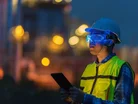Lloyd's Register: Construction 'Most Dangerous Industry'

The construction industry has been identified as one of the most hazardous sectors in which to work globally, according to a new heavyweight report.
The report, from Lloyd's Register Foundation – an independent global safety charity – is called ‘Engineering safer workplaces’, and draws on data from the World Risk Poll conducted by Gallup, the global analytics firm.
The poll, which involved 147,000 interviews across 142 countries, found that 22% of construction workers have experienced harm in the workplace over the past two years. This figure is significantly higher than the global average of 18% across all industries.
Tim Slingsby, Director of Skills and Education at Lloyd's Register Foundation, says: "The construction industry, and the people in it, are a vital part of our lives. Yet, construction is one of the most dangerous occupations in the world – and the World Risk Poll indicates an alarming lack of occupational safety and health training within it."
The report identifies several potential causes for the high harm rate in construction. These include working with heavy machinery, prolonged exposure to outdoor elements, and contact with hazardous substances. Additionally, the data reveals a gender disparity in workplace harm, with men experiencing higher rates than women.
Chris Alderson, Chief Executive Officer at Construction Health and Safety New Zealand, adds: "The risks faced by construction workers are the same for everybody regardless of where they are in the world – whether that's falling from height, electrocution, handling heavy materials or working in volatile weather conditions."
CITB courses address construction safety concerns
The report's findings underscore the importance of comprehensive safety training in the construction industry. Organisations such as NEBOSH (National Examination Board in Occupational Safety and Health) and CITB (Construction Industry Training Board) offer specialised courses to address these concerns.
NEBOSH provides a Health and Safety Management for Construction qualification, which covers essential topics such as CDM (Construction Design and Management) regulations, risk assessment, and managing change on construction sites. The course is designed for construction site managers, contracts managers, and site workers with health and safety responsibilities.
Similarly, CITB offers a range of Site Safety Plus courses, including the Site Management Safety Training Scheme (SMSTS) and Site Supervisors' Safety Training Scheme (SSSTS). These courses are accredited by CITB and aim to equip construction professionals with the skills to manage health and safety issues effectively.
Alderson emphasises the importance of tailored training: "While there is often training on competency, which is often based on procedures, there tends to be a gap in knowledge and awareness of actual risks they will face on site. The risk environment in construction is volatile. Things change quickly and training must take account of this."
Global disparities in construction safety training
The World Risk Poll reveals significant regional differences in safety training provision within the construction industry. In Australia and New Zealand, 82% of construction workers report receiving recent workplace safety training. In stark contrast, only 6% of workers in Northern Africa report the same.
Employment status also plays a role in access to safety training. Among construction workers, 43% of those employed full-time for an employer receive health or safety training, compared to just 33% of self-employed workers.
Stephen Wisniewski, Associate Director at TWI Training and Examinations, comments on the situation in Southeast Asia: "From our own research, a high percentage of workers have confirmed they have been asked to work on jobs they have not had the necessary training for, with almost half (49%) saying they had agreed to such work."
To address these disparities, initiatives like the South East Asia Skills Enhancement Programme (SEASEP) have been established. SEASEP aims to provide qualifications and certifications to promote safer practices in countries such as Indonesia, The Philippines, Thailand, and India.
Slingsby concludes: "Promisingly, we know that accidents and fatalities can be significantly reduced if workforces are trained to implement recognised safety practices. That's why we partner with organisations like TWI, with whom we are delivering the South East Asia Skills Enhancement Programme (SEASEP)."
------------------
Construction Digital is a BizClik brand




